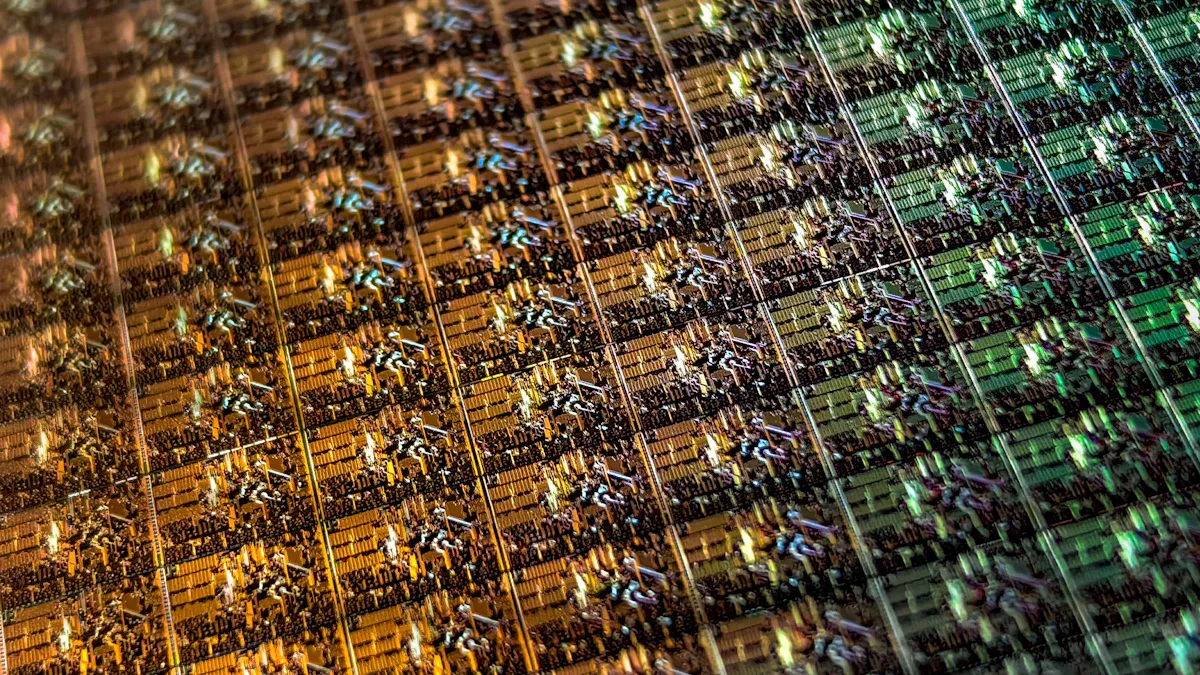
Tantalum Carbide Coating represents a pivotal innovation in semiconductor manufacturing, offering exceptional durability for equipment operating under extreme conditions. This ultra-hard material ensures components can endure high temperatures, corrosive environments, and mechanical stress with ease. Semiconductor OEMs depend on this advanced coating to meet the rigorous demands of modern fabrication processes. Cutting-edge solutions such as SIC COATING and CVD SIC COATING deliver enhanced performance, setting a new standard in the industry. TAC COATING, particularly when utilized as a CVD TAC COATING, provides unparalleled protection, significantly extending the lifespan and efficiency of semiconductor tools. Ningbo VET Energy Technology Co., Ltd is proud to support these advancements with its expertise in coating technologies.
Key Takeaways
- Tantalum carbide coating is very hard, making it super strong. This strength protects tools from damage and helps them last longer.
- Its high melting point of 3880°C keeps it stable in heat. This lets machines work well even in very hot conditions.
- Tantalum carbide does not react with chemicals, so it resists rust. This keeps semiconductor products clean during production.
- Using this coating makes processes better by handling heat well. It also lowers the chance of contamination, helping make more good products.
- Adding tantalum carbide coating can save money on repairs. It reduces damage, so companies can use their resources better.
Technical Specifications of Tantalum Carbide Coating
Hardness and Wear Resistance
Tantalum carbide coating exhibits exceptional hardness, making it one of the most durable materials for semiconductor applications. Its hardness ranges from 9 to 10 on the Mohs scale, placing it among the hardest known materials. This property ensures that components coated with tantalum carbide can withstand significant mechanical stress and abrasive wear during high-precision manufacturing processes.
Studies have validated the wear resistance of tantalum carbide coatings through various testing methods:
- Indentation experiments revealed anomalous hardness behavior, highlighting the material’s robustness.
- Nanoindentation tests on bulk and thin-film TaCx samples demonstrated consistent results, with each data point derived from 50 tests.
- Scanning Electron Microscope (SEM) images of indents showed distinct deformation patterns. Bulk samples exhibited pile-up, while thin films displayed cracking, correlating with their wear resistance.
These findings underscore the reliability of tantalum carbide coating in protecting semiconductor tools from wear and tear, ensuring long-term performance in demanding environments.
Thermal Stability and High Melting Point
Tantalum carbide coating offers remarkable thermal stability, making it ideal for high-temperature applications. With a melting point of 3880°C, it can endure extreme heat without compromising its structural integrity. This property is critical for semiconductor equipment operating under intense thermal conditions.
Experimental data further supports the thermal stability of tantalum carbide:
- Laser melting analysis of the TaC-HfC system confirmed the high melting temperatures of tantalum carbide.
- While hafnium carbide (HfC) exhibited the highest melting point in the system at 4232 ± 84 K, tantalum carbide demonstrated excellent stability in mixed compositions, such as Ta0.8Hf0.2C.
- These results highlight tantalum carbide’s ability to maintain performance even in compositions designed for specific thermal requirements.
This combination of a high melting point and thermal stability ensures that tantalum carbide coating can protect semiconductor components in extreme heat, enhancing their reliability and lifespan.
Chemical Inertness and Corrosion Resistance
Tantalum carbide coating is highly chemically inert, providing exceptional resistance to corrosion and chemical degradation. This property is particularly valuable in semiconductor manufacturing, where equipment often encounters reactive gases and harsh chemicals.
The coating’s chemical stability ensures that it remains unaffected by corrosive environments, preserving the integrity of the underlying substrate. This resistance minimizes the risk of contamination during sensitive manufacturing processes, maintaining the purity and quality of semiconductor products.
By combining chemical inertness with other advanced properties, tantalum carbide coating delivers unparalleled protection for semiconductor tools, enabling them to perform reliably in challenging operational conditions.
Electrical and Thermal Conductivity
Tantalum carbide coating exhibits impressive electrical and thermal conductivity, making it a valuable material for semiconductor manufacturing. Its metallic electrical conductivity ensures efficient charge transfer, which is essential for components operating in high-performance environments. This property supports the development of advanced semiconductor tools that require precise electrical behavior.
In terms of thermal conductivity, tantalum carbide coating demonstrates a value of 21 W/(m·K). This level of thermal performance allows it to dissipate heat effectively, preventing overheating in critical components. By maintaining stable temperatures, the coating enhances the reliability and efficiency of semiconductor equipment.
These properties make tantalum carbide coating an ideal choice for applications where both electrical and thermal management are crucial. Its ability to combine these characteristics ensures that semiconductor tools can operate under demanding conditions without compromising performance.
Sputtering Target Properties (Purity, Density, Bonding)
Sputtering targets play a pivotal role in the deposition of tantalum carbide coatings, and their properties significantly influence the quality of the final coating. Key attributes such as purity, density, and bonding methods determine the performance and reliability of the sputtering process.
Purity
The purity of tantalum carbide sputtering targets is critical for achieving high-quality coatings. Available purity levels include:
- 99%
- 99.9%
- 99.99%
- 99.999%
Higher purity levels reduce the risk of contamination during the coating process, ensuring superior performance and durability of the coated components.
Bonding Methods
Sputtering targets for tantalum carbide coatings utilize advanced bonding techniques to ensure stability and efficiency during deposition. Common bonding methods include:
- Indium bonding: Provides excellent thermal conductivity and mechanical stability.
- Elastomer bonding: Offers flexibility and durability, making it suitable for specific applications.
Summary Table of Key Properties
| Property | Value |
|---|---|
| Purity | 99.5% |
| Type of Bond | Indium, Elastomer |
Although the density of tantalum carbide sputtering targets is not explicitly available, the combination of high purity and reliable bonding methods ensures optimal performance during the coating process. These properties enable semiconductor OEMs to achieve consistent and high-quality coatings, enhancing the functionality and longevity of their equipment.
Applications of Tantalum Carbide Coating in Semiconductor Manufacturing

MOCVD and PECVD Equipment
Metal-Organic Chemical Vapor Deposition (MOCVD) and Plasma-Enhanced Chemical Vapor Deposition (PECVD) processes are critical in semiconductor manufacturing. These techniques involve high-temperature environments and exposure to reactive gases, which can degrade unprotected equipment over time. Tantalum carbide coating provides a robust solution by enhancing the durability and performance of components used in these systems.
The coating’s high-temperature stability, exceeding 2200°C, ensures that deposition chambers and internal components maintain their structural integrity during prolonged operation. Its chemical resistance protects against corrosive gases like hydrogen and ammonia, which are commonly used in MOCVD and PECVD processes. Furthermore, the ultra-high purity of tantalum carbide coating minimizes contamination risks, preserving the quality of deposited films.
Key benefits of tantalum carbide coating in MOCVD and PECVD equipment include:
- Prolonged equipment lifespan due to superior wear and corrosion resistance.
- Enhanced process efficiency by maintaining consistent thermal and chemical properties.
- Reduced maintenance requirements, leading to lower operational costs.
Wafer Processing and Etching Chambers
Wafer processing and etching chambers demand materials that can withstand abrasive plasma environments and harsh chemical reactions. Tantalum carbide coating excels in these applications by offering exceptional hardness and chemical inertness. Its ability to resist wear and corrosion ensures that chamber walls, electrodes, and other critical components remain functional under extreme conditions.
The coating’s thermal and mechanical durability also plays a vital role in wafer processing. Strong adhesion to graphite and low thermal expansion prevent cracking or delamination during thermal cycling. This reliability is crucial for maintaining the precision and consistency required in semiconductor fabrication.
Applications in wafer processing and etching chambers include:
- Protective linings for chamber walls to prevent erosion from plasma exposure.
- Coated electrodes and shields to reduce contamination and improve yield.
- Enhanced thermal management for consistent process performance.
| Property | Description |
|---|---|
| High-Temperature Stability | Withstands temperatures exceeding 2200°C, outperforming traditional materials like silicon carbide (SiC). |
| Chemical Resistance | Resists corrosion from hydrogen, ammonia, silicon vapors, and molten metals, critical for semiconductor processing. |
| Ultra-High Purity | Impurity levels below 5 ppm, minimizing contamination risks in crystal growth processes. |
| Thermal and Mechanical Durability | Strong adhesion to graphite, low thermal expansion, and high hardness ensure longevity under thermal cycling. |
High-Temperature and High-Wear Components
Semiconductor manufacturing involves components that must endure extreme heat and mechanical stress. Tantalum carbide coating provides unmatched protection for high-temperature and high-wear parts, ensuring their longevity and reliability.
The coating’s high melting point and superior hardness make it ideal for applications such as crucibles, nozzles, and other high-stress components. For example, in SiC single crystal growth, tantalum carbide-coated graphite crucibles suppress contamination and enhance thermal management. Similarly, in epitaxial growth processes like GaN/SiC, the coating prevents gas reactions and minimizes defects, improving overall yield.
| Property | Benefit |
|---|---|
| High melting point | Excellent thermal stability in high-temperature applications |
| Superior hardness | Enhanced wear and abrasion resistance in demanding environments |
| Excellent chemical resistance | Long-lasting durability in harsh conditions |
| Strong thermal stability | Preserves material integrity under extreme heat |
These properties ensure that tantalum carbide coating not only extends the lifespan of high-wear components but also enhances their performance in critical semiconductor processes.
Protective Coatings for Semiconductor Tools
Protective coatings play a vital role in safeguarding semiconductor tools from wear, corrosion, and thermal stress. Tantalum carbide coating stands out as a premier solution due to its exceptional durability and performance characteristics. This advanced material ensures that tools used in semiconductor manufacturing maintain their integrity and functionality under demanding conditions.
Key Benefits of Tantalum Carbide Coating for Semiconductor Tools
- Wear Resistance: Tantalum carbide coatings provide unmatched protection against abrasion, extending the lifespan of critical components. This feature is essential for tools exposed to high-friction environments during wafer processing and etching.
- Thermal Stability: The coating’s ability to withstand extreme temperatures ensures reliable operation of semiconductor tools in high-heat applications. This property minimizes thermal degradation, preserving the precision of manufacturing processes.
- Enhanced Lifecycle: By improving the durability and efficiency of semiconductor equipment, tantalum carbide coatings reduce the frequency of replacements and maintenance, optimizing operational reliability.
Applications in Semiconductor Tools
Tantalum carbide coating is widely applied to various semiconductor tools to enhance their performance and longevity. These applications include:
- Chamber Linings: Protective coatings on chamber walls prevent erosion caused by plasma exposure and chemical reactions during wafer processing.
- Electrodes and Shields: Coated electrodes and shields reduce contamination risks, ensuring consistent yields in semiconductor fabrication.
- High-Wear Components: Tools such as nozzles and crucibles benefit from the coating’s superior hardness, which resists mechanical stress and wear.
Reliability Statistics Supporting Tantalum Carbide Coating
Tantalum carbide coatings have demonstrated exceptional reliability in protecting semiconductor tools.
- They offer superior wear resistance, ensuring tools remain functional despite abrasive conditions.
- Their thermal stability allows tools to operate effectively under extreme temperatures, maintaining process accuracy.
- By enhancing the lifecycle and efficiency of equipment, these coatings contribute to consistent performance reliability.
The integration of tantalum carbide coating into semiconductor tools represents a significant advancement in manufacturing technology. Ningbo VET Energy Technology Co., Ltd leverages its expertise to deliver high-quality coatings that meet the rigorous demands of the semiconductor industry.
Deposition Processes for Tantalum Carbide Coating

Chemical Vapor Deposition (CVD)
Chemical Vapor Deposition (CVD) is a widely used technique for applying tantalum carbide coating. This process involves the chemical reaction of gaseous precursors on a heated substrate, forming a solid, uniform coating. CVD ensures high purity and excellent adhesion, making it ideal for semiconductor applications.
Key parameters influence the quality of CVD coatings:
- Deposition Temperature: Higher temperatures increase deposition rates and grain sizes but may introduce defects. Lower temperatures improve efficiency but reduce coating thickness.
- Gas Flow Rates: Optimal molar ratios of precursor gases ensure consistent coating composition and properties.
- Deposition Pressure: Higher pressure allows for thicker coatings, while lower pressure enhances uniformity.
| Parameter | Value |
|---|---|
| Density | 14.3 g/cm³ |
| Coating Thickness | ≥20 µm (typical value: 35 µm + 10 µm) |
| Thermal Stability | <2500°C |
| Hardness | 2000 HK |
CVD offers unmatched precision and reliability, ensuring tantalum carbide coating meets the rigorous demands of semiconductor manufacturing.
Physical Vapor Deposition (PVD)
Physical Vapor Deposition (PVD) employs physical processes, such as evaporation or sputtering, to deposit tantalum carbide coating. This method produces thin films with high density and uniformity, making it suitable for applications requiring precise control over coating thickness.
PVD operates under vacuum conditions, which minimizes contamination and enhances coating purity. The process parameters, including substrate temperature and deposition rate, are carefully controlled to achieve optimal results.
Advantages of PVD include:
- High efficiency in material utilization.
- Uniform film thickness distribution.
- Low particle generation, ensuring smooth coatings.
PVD remains a preferred choice for semiconductor OEMs seeking high-performance coatings with minimal defects.
Sputtering Techniques
Sputtering techniques involve bombarding a target material, such as tantalum carbide, with high-energy particles to eject atoms that deposit onto a substrate. This method ensures precise control over coating thickness and composition, making it ideal for advanced semiconductor tools.
The tantalum carbide sputtering target is available in various forms, including discs, plates, and custom-made shapes, with a purity of 99.5%. Common dimensions include:
- Circular Targets: Sizes range from 1.0” to 21”.
- Rectangular Targets: Sizes include 5” x 12” to 6” x 20”.
| Type | Dimensions | Thickness |
|---|---|---|
| Circular Targets | 1.0” to 21” | N/A |
| Rectangular Targets | 5” x 12” to 6” x 20” | 0.125” to 0.25” |
Sputtering offers high efficiency, uniform film distribution, and low particle generation, ensuring consistent performance in semiconductor manufacturing.
Quality Control in Coating Processes
Quality control plays a critical role in ensuring the reliability and performance of tantalum carbide coatings for semiconductor applications. Manufacturers must implement stringent measures to maintain consistency, precision, and adherence to industry standards. These processes guarantee that the coatings meet the demanding requirements of semiconductor OEMs.
Key Quality Control Measures
Material Inspection:
Raw materials, such as tantalum carbide powders and sputtering targets, undergo thorough inspection. Parameters like purity, particle size, and density are evaluated to ensure they meet predefined specifications.
Coating Thickness Measurement:
Advanced tools, such as scanning electron microscopes (SEM) and profilometers, measure coating thickness. This ensures uniformity across the substrate and compliance with design requirements.
Adhesion Testing:
Adhesion strength is tested using methods like scratch testing. This step verifies that the coating bonds effectively to the substrate, preventing delamination during operation.
Surface Analysis:
Techniques like X-ray diffraction (XRD) and energy-dispersive X-ray spectroscopy (EDS) analyze the coating’s composition and crystalline structure. These tests confirm the absence of impurities and defects.
Importance of Quality Control
Consistent quality control ensures that tantalum carbide coatings deliver optimal performance in high-temperature and corrosive environments.
By maintaining strict oversight, manufacturers can reduce defects, improve equipment longevity, and enhance process efficiency. Ningbo VET Energy Technology Co., Ltd employs advanced quality control protocols to deliver coatings that meet the highest industry standards, ensuring reliability for semiconductor OEMs.
Benefits of Tantalum Carbide Coating for Semiconductor OEMs
Enhanced Equipment Longevity
Tantalum carbide coating significantly extends the lifespan of semiconductor equipment. Its exceptional hardness and wear resistance protect critical components from mechanical stress and abrasive environments. This durability ensures that tools and machinery maintain their structural integrity even under prolonged use. For example, components coated with tantalum carbide can endure high temperatures and corrosive conditions without degradation. This longevity reduces the frequency of replacements, allowing semiconductor OEMs to focus on production rather than equipment downtime.
Improved Process Efficiency
The application of tantalum carbide coating enhances the efficiency of semiconductor manufacturing processes. Its high thermal conductivity ensures effective heat dissipation, preventing overheating and maintaining stable operating conditions. Additionally, the coating’s chemical inertness minimizes contamination risks, preserving the purity of materials during fabrication. These properties enable equipment to operate at peak performance, resulting in higher yields and consistent product quality. By optimizing process efficiency, tantalum carbide coating supports the development of advanced semiconductor technologies.
Reduced Maintenance Costs
Tantalum carbide coating reduces maintenance costs by minimizing wear and tear on equipment. Its robust properties eliminate the need for frequent repairs or replacements, leading to significant cost savings. Studies have demonstrated its financial benefits across industries:
- A 2024 study by the European Wind Energy Association reported a 17% reduction in blade maintenance costs for turbines using TaC-coated tooling.
- Tantalum carbide coatings enhance thermal efficiency and reduce maintenance expenses in demanding applications such as semiconductor manufacturing and aerospace.
These findings highlight the economic advantages of adopting tantalum carbide coating. By lowering maintenance requirements, semiconductor OEMs can allocate resources more effectively, improving overall operational efficiency.
Compatibility with Advanced Manufacturing
Tantalum carbide coating aligns seamlessly with the demands of advanced semiconductor manufacturing. Its unique properties enable it to meet the rigorous requirements of cutting-edge processes, ensuring optimal performance and reliability. Semiconductor OEMs rely on materials that can withstand extreme conditions while maintaining precision and efficiency. Tantalum carbide coating delivers on these fronts, making it an indispensable choice for modern fabrication technologies.
The coating’s ability to endure high temperatures and resist chemical degradation makes it ideal for advanced manufacturing environments. Processes such as chemical vapor deposition (CVD) and epitaxial growth require materials that can maintain structural integrity under intense thermal and mechanical stress. Tantalum carbide-coated components excel in these scenarios, ensuring consistent performance even in the most demanding conditions.
Key integration test data highlights its compatibility with advanced semiconductor processes:
- Tantalum carbide-coated susceptors play a critical role in CVD and epitaxial growth applications.
- These components maintain structural integrity and performance at temperatures exceeding 1,600°C.
- The growing demand for TaC-coated susceptors reflects the industry’s need for high-temperature processing capabilities.
The coating’s exceptional thermal stability and chemical inertness also reduce contamination risks, preserving the purity of semiconductor materials. This ensures that advanced manufacturing processes achieve the precision and consistency required for next-generation technologies.
By integrating tantalum carbide coating into their equipment, semiconductor OEMs can enhance process efficiency, improve product quality, and meet the evolving demands of the industry. Ningbo VET Energy Technology Co., Ltd continues to support these advancements by delivering high-performance coatings tailored to the needs of modern manufacturing.
Future Trends in Tantalum Carbide Coating Technology
Innovations in Deposition Techniques
Advancements in deposition techniques are shaping the future of tantalum carbide coating. High-Power Impulse Magnetron Sputtering (HiPIMS) and RF Magnetron Sputtering have emerged as promising methods. HiPIMS enables lower substrate temperatures, producing coatings with coarser microstructures at higher tantalum content. For instance, coatings with 24% tantalum exhibit a hardness exceeding 41 GPa at a substrate temperature of 300°C. In contrast, RF Magnetron Sputtering requires higher substrate temperatures, above 400°C, to achieve a crystalline structure with finer microstructures.
| Deposition Technique | Key Findings | Microstructure Changes | Hardness (GPa) | Substrate Temperature (°C) |
|---|---|---|---|---|
| HiPIMS | Lower substrate temperatures; coarser microstructure at higher tantalum content. | Coarser with 24% tantalum. | > 41 | 300 |
| RF Magnetron Sputtering | Higher substrate temperatures needed for crystalline structure. | Finer without tantalum. | N/A | > 400 |
These innovations enhance coating performance, making them suitable for high-precision semiconductor applications.
Development of Ultra-Pure Materials
The demand for ultra-pure tantalum carbide materials is rising as semiconductor manufacturing evolves. Purity levels exceeding 99.999% are becoming standard to minimize contamination risks and improve coating quality. Advanced refining techniques, such as plasma arc melting and chemical purification, ensure the production of ultra-pure materials. These methods reduce impurities, enhancing the coating’s thermal stability and chemical resistance.
Ultra-pure tantalum carbide materials also support the development of sputtering targets with superior performance. These targets enable consistent deposition, ensuring the reliability of semiconductor tools. By prioritizing purity, manufacturers can meet the stringent requirements of next-generation semiconductor technologies.
Emerging Applications in Semiconductor Manufacturing
Tantalum carbide coating is finding new applications in semiconductor manufacturing. Vacuum furnaces, for example, benefit from its ability to combat oxidation and enhance thermal stability. This coating also improves the durability and efficiency of high-temperature components.
| Application | Benefits |
|---|---|
| Vacuum furnaces | Combat oxidation, enhance durability, thermal stability, and efficiency in high-temperature applications |
Additionally, the coating is being integrated into advanced wafer processing tools and etching chambers. Its exceptional hardness and chemical inertness ensure reliable performance in abrasive and corrosive environments. As semiconductor devices become more complex, tantalum carbide coating will play a critical role in enabling precise and efficient manufacturing processes.
Sustainability and Eco-Friendly Solutions
Sustainability has become a critical focus in semiconductor manufacturing. Tantalum carbide coating supports eco-friendly practices by enhancing equipment efficiency and reducing waste. Its durability minimizes the need for frequent replacements, which lowers material consumption and energy usage during production.
Key Contributions to Sustainability
- Extended Equipment Lifespan: Tantalum carbide coating significantly increases the longevity of semiconductor tools. This reduces the environmental impact associated with manufacturing and disposing of replacement parts.
- Energy Efficiency: The coating’s high thermal conductivity ensures effective heat management. This property reduces energy consumption in high-temperature processes, contributing to greener operations.
- Reduced Material Waste: By protecting components from wear and corrosion, tantalum carbide coating minimizes material degradation. This leads to less frequent maintenance and fewer discarded parts.
Note: A study by the Semiconductor Industry Association (SIA) highlighted that advanced coatings like tantalum carbide can reduce waste by up to 25% in wafer processing equipment.
Eco-Friendly Manufacturing Practices
Ningbo VET Energy Technology Co., Ltd prioritizes sustainability in its production processes. The company employs advanced refining techniques to produce ultra-pure tantalum carbide materials with minimal environmental impact. These methods reduce emissions and optimize resource utilization, aligning with global sustainability goals.
Future Outlook
The integration of tantalum carbide coating into semiconductor manufacturing supports the industry’s transition toward greener technologies. As demand for sustainable solutions grows, innovations in coating technology will play a pivotal role in reducing the environmental footprint of advanced manufacturing processes.
By adopting tantalum carbide coating, semiconductor OEMs can achieve both operational excellence and environmental responsibility. This dual benefit positions the coating as a cornerstone of sustainable manufacturing practices.
Tantalum Carbide Coating has proven to be a transformative solution for semiconductor manufacturing. Its exceptional hardness, thermal stability, and chemical resistance ensure that equipment operates reliably under extreme conditions. These technical specifications, combined with its ability to enhance process efficiency and reduce maintenance costs, make it indispensable for modern fabrication processes.
By integrating this advanced coating, semiconductor OEMs can significantly improve the durability and performance of their tools. This innovation not only supports the development of cutting-edge technologies but also aligns with the industry’s push for sustainable and efficient manufacturing practices. Adopting tantalum carbide coating positions OEMs to meet the evolving demands of the semiconductor market with confidence.
FAQ
What makes tantalum carbide coating ideal for semiconductor manufacturing?
Tantalum carbide coating offers exceptional hardness, thermal stability, and chemical resistance. These properties protect equipment from wear, corrosion, and extreme temperatures, ensuring reliable performance in demanding semiconductor processes. Its ability to maintain purity minimizes contamination risks, making it indispensable for high-precision manufacturing.
How is tantalum carbide coating applied to semiconductor tools?
Manufacturers use deposition techniques like Chemical Vapor Deposition (CVD), Physical Vapor Deposition (PVD), and sputtering. These methods ensure uniform coatings with high adhesion and purity. Each process is tailored to meet specific requirements, such as thickness, density, and thermal stability.
Can tantalum carbide coating reduce maintenance costs for OEMs?
Yes, its durability minimizes wear and tear, reducing the need for frequent repairs or replacements. By extending equipment lifespan, tantalum carbide coating lowers operational costs and enhances efficiency, allowing OEMs to allocate resources more effectively.
What purity levels are available for tantalum carbide sputtering targets?
Purity levels range from 99% to 99.999%. Higher purity ensures superior coating quality by reducing contamination risks during deposition. Semiconductor OEMs often prefer ultra-pure targets for advanced manufacturing processes.
Is tantalum carbide coating environmentally friendly?
Tantalum carbide coating supports sustainability by extending equipment lifespan and reducing waste. Its energy-efficient properties, such as high thermal conductivity, lower energy consumption during manufacturing. Ningbo VET Energy Technology Co., Ltd prioritizes eco-friendly production practices to align with global sustainability goals.






